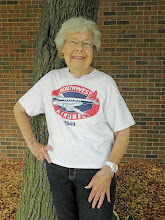Mystery of the Missing Organist Solved!
In the chapter titled "Organic Stratocruiser" in my new book Fujiyama Trays & Oshibori Towels, Recalling a time when passenger flight was an adventure and the Boeing Stratocruiser ruled the skies, a story is told of a flight from New York's Idlewild (now JFK) airport to Minneapolis-St. Paul on a Northwest Airlines Stratocruiser equipped with a Lowrey organ, but alas - no organist to play it.
George Grim, a passenger on the flight and a popular columnist for the Minneapolis Morning Tribune, saved the day by playing the organ all the way to MSP. And then wrote his column "I Like it Here" about the adventure! I wondered when I researched this why there was no "official" organist on board that day.
This week, in talking with C. R. "Chuck" Swanson, Jr., I learned that he was supposed to be playing the organ on that flight. Chuck is the son of C. R. "Swanee" Swanson, owner of Northwest Organ Company, donor of the Lowrey organ to Northwest and chief "airborne organist." Sadly "Swanee" Swanson passed away last fall at the age of 95. His son, Chuck was listed in a 1959 newspaper account as one of the regular organists. I finally tracked him down.
I asked Chuck how many times he was the "flying organist." He replied, "Once." He was 19 years old at the time, had worked the flight to New York from Minneapolis-St. Paul, found his way in to Manhattan and checked into his hotel. Unfortunately, ship 709, the only Stratocruiser with an organ on board, was assigned to a return flight different from the one he had been given, and Chuck missed the flight.
Chuck's absence on that flight, and George Grim playing his way home to MSP, resulted in wonderful publicity for the airline when George told his story in his column. The passengers loved it, George's readers loved it and so did the Northwest public relations department
.
Next time I talk to Chuck I am going to ask him how he got home that day.
And by the way, Chuck will tell his story on Saturday, February 7 at the Fujiyama Trays & Oshibori Towels book launch party at the NWA History Centre, 8101 34th Ave. So, Bloomington, MN, 11 a.m. to 2 p.m. R.S.V.P. to anne@ladyskywriter.com.







